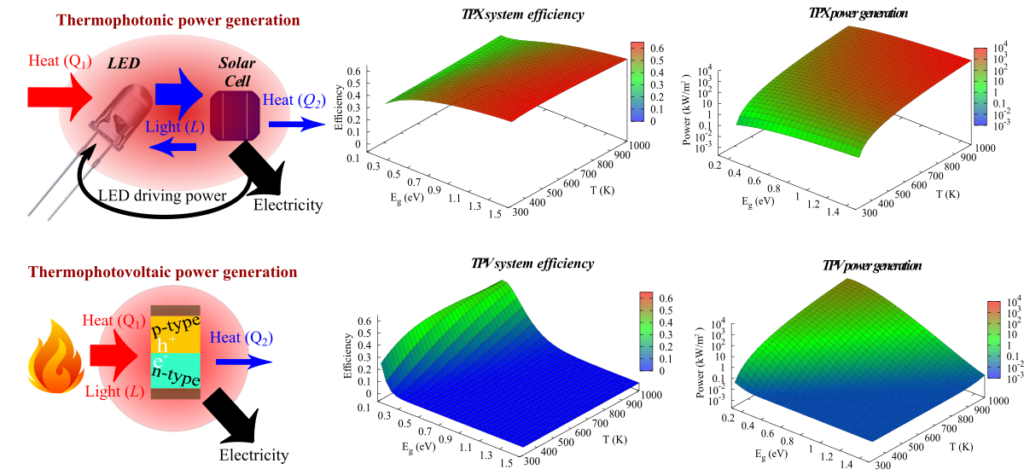Originally thermophotonics referred to a system optically coupling a light emitting diode to a photovoltaic cell, intended to harvest solar energy after converting it to heat and then back to monochromatic light. We define the concept a bit more broadly as “using thermal energy and thermodynamics of light to realize optical thermodynamic machines” (and to better understand other components).
Thermophotonic (TPX) power generation from waste heat is one possible concept arising from the intimate coupling of light emission, thermal energy and electronic excitation that may lead to new possibilities in thermal energy harvesting. In the original studies aiming at solar energy harvesting, the hot body of a conventional thermophotovoltaic (TPV) system that radiates thermal energy towards a photovoltaic cell was replaced by a hot light emitting diode (LED) using the sun as the heat source. In contrast to a TPV system, the thermal emission from the hot LED could be made super-thermal, so that it could radiate more power than predicted by Planck’s law, by electrically biasing the hot LED. In further contrast to TPV, the photovoltaic (PV) cell was to be made of a large band gap semiconductor material. While promising, the concept faced two at the time insurmountable challenges: (1) To compete with the efficiency of best solar cells, the temperature of the LEDs was envisioned to be extremely high (>> 1000 K), and (2) the quantum efficiency of the light emitter was to be near unity enabling the so called electroluminescent cooling (ELC) operating regime. At the time, the latter condition was probed only by experiments aiming to develop high efficiency photoluminescent coolers, considered to be representative and easier to explore. On a closer look, however, the excitation mechanisms for photoluminescent devices and LEDs are quite different, and electrical excitation may allow a fundamentally more efficient way to excite the emitter.

Figure 1: Schematic illustrations of the basic principles of a thermophotonic (TPX) and thermophotovoltaic (TPV) heat engines. Under ideal conditions the TPX system can operate at very high system efficiencies and powers over a broad range of temperatures and material bandgaps, whereas TPV systems typically require very small bandgap materials and high temperatures.
After the first studies of energy harvesting, it was suggested that the effect would also work in reverse, and that similar structures could be used as optical coolers and heat pumps. For such applications, the operating temperatures could remain much closer to room temperature, where the heat transport is inherently more efficient. Recent studies have produced several results indicating that it is possible to fabricate LEDs with a quantum efficiency that is, in principle, sufficient to access the operating regime allowing electroluminescent (EL) cooling. This implies that now also TPX energy harvesting is possible, if the LED and the PV cell in the TPX configuration can be thermally insulated while the strong optical coupling present in the prototype devices can be maintained. This provides new possibilities in harvesting thermal energy from the abundant waste heat sources outside the original concept of solar energy harvesting.
